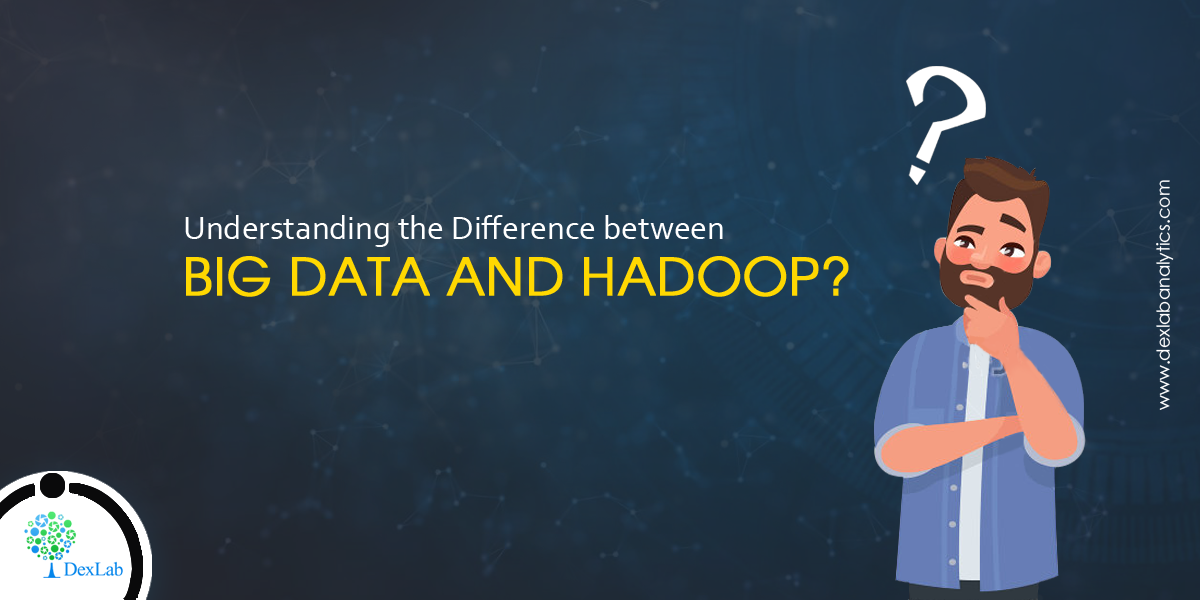A lot of IT professionals and tech nerds are curious to learn about the difference between Big Data and Hadoop. A majority of them are yet to understand the subtle line of distinction between the two. And the increasing prominence and popularity of Big Data Hadoop certification has further added to the confusion.
Importantly, Big Data and Hadoop, the most popular open-source Hadoop program actually ends up complementing each other, in every way. If you think of Big Data as a problem then Hadoop acts like a solution for that problem – yes, they are that much compatible and complementary to each other. While big data is a dubious and complex concept, Hadoop being a simple, open source program that helps in fulfilling a certain creed of objectives of asset, in this case Big Data.
The best way to explain this issue would be by talking about the challenges associated with Big Data and how Hadoop efficiently resolves them – this would be the best way to know the differences between the two.
Challenges with Big Data
Big Data is best defined with 5 characteristics: Volume, Variety, Velocity, Value and Veracity. Here, volume depicts the quantity of data, variety means the kind of data, velocity is the rate at which data is being generated, value points at the usefulness of the data and veracity is the amount of inconsistent data.
Now, let’s talk about two of the emerging problems with Big Data:
- Storage – The archaic storage solutions are not adept enough to store such mammoth amount of data that is being generated every day. Moreover, the variety of data is different, thus the data needs to be stored separately for effective use.
- Speed of accessing and processing data – Though the hard disk capacities have increased manifold, not much development has been done on the front of the speed of accessing or processing data.
But no more, you have to worry about all these issues, as Hadoop is here. It has effectively mitigated all the above-mentioned challenges and made big data powerful as a rock!
What is Hadoop?
Generally speaking, Hadoop is an open source programming platform – it helped big data to get stored in distributed environments so as to be processed in a parallel way. It is composed of two important elements – Hadoop Distributed File System (HDFS) and YARN (Yet Another Resource Negotiator), Hadoop’s processing unit.
Now, let’s see how Hadoop resolves the emerging big data challenges:
- Storage – With the help of HDFS, Big Data can now be stored in a proper distributed manner. For that, datanode block is used, it’s an efficient storage solution and allows you to specify the size of every block in use. Additionally, it doesn’t only divides the data across different blocks but also replicated all the blocks on the data nodes, thus making way for better storage solution.
- The speed of accessing and processing data – Instead of relying on traditional methodologies, Hadoop prefers moving processing to the data, which means the processing dynamo is moved across different slave nodes and parallel processing of data is carried on throughout the slave nodes. And the processed results are then shifted into a master node, where a mixing of data takes place and the response arising out of it is sent to the client.
Hence, you can see how big data and hadoop are related to each other, not like alternatives but like complements. So, to climb the ladder of success and be an ace developer or data scientist, Big Data Hadoop certification in Gurgaon is your go-to option. Get Big Data Hadoop certification today from DexLab Analytics.
Interested in a career in Data Analyst?
To learn more about Data Analyst with Advanced excel course – Enrol Now.
To learn more about Data Analyst with R Course – Enrol Now.
To learn more about Big Data Course – Enrol Now.To learn more about Machine Learning Using Python and Spark – Enrol Now.
To learn more about Data Analyst with SAS Course – Enrol Now.
To learn more about Data Analyst with Apache Spark Course – Enrol Now.
To learn more about Data Analyst with Market Risk Analytics and Modelling Course – Enrol Now.

